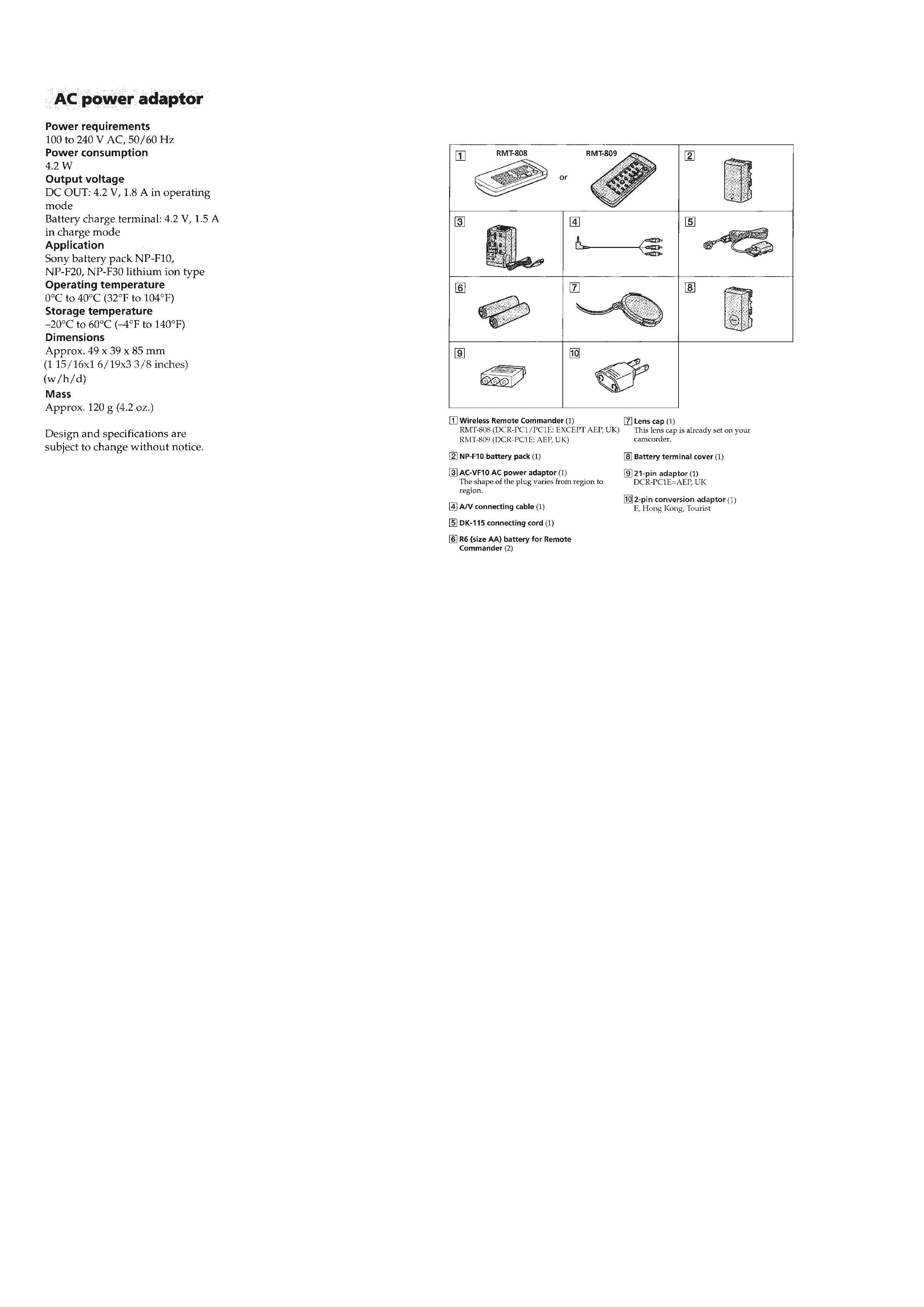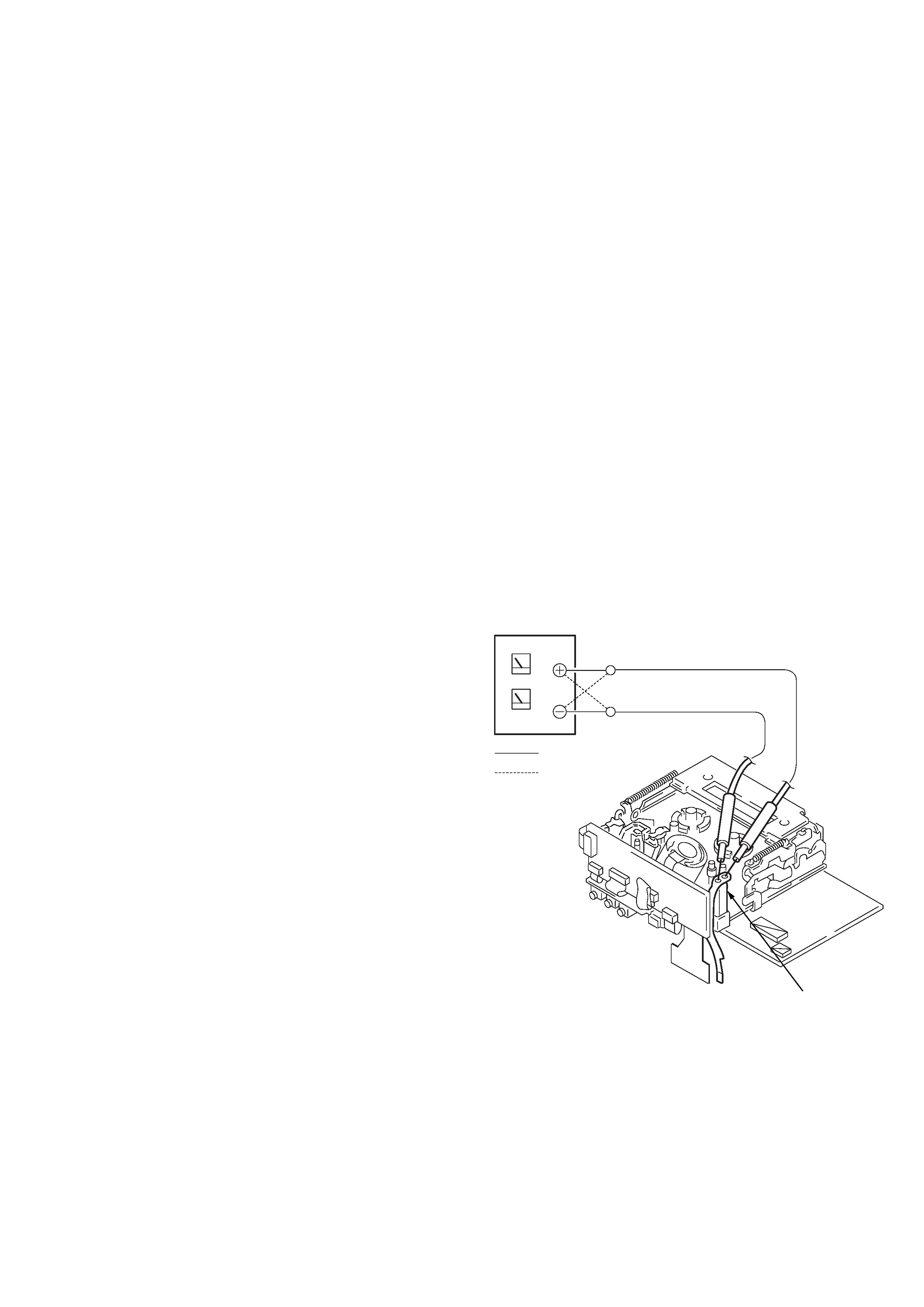
DCR-PC1/PC1E
RMT-808/809
US Model
Canadian Model
DCR-PC1
AEP Model
UK Model
Australian Model
Chinese Model
DCR-PC1E
E Model
Hong Kong Model
Tourist Model
DCR-PC1/PC1E
SERVICE MANUAL
MICROFILM
D200 MECHANISM
DCR-PC1: NTSC model
DCR-PC1E: PAL model
SPECIFICATIONS
For MECHANISM ADJUSTMENTS, refer to the "DV MEHCANICAL
ADJUSTMENT MANUAL
D MECHANISM " (original: 9-973-815-11,
supplement: 9-973-815-81) and "DV MECHANICAL ADJUSTMENT
MANUAL
D200 MECHANISM " (original: 9-973-981-11).
Photo: DCR-PC1E
RMT-809
DIGITAL VIDEO CAMERA RECORDER
-- Continued on next page --
Ver 1.0
1998. 07

-- 2 --
SAFETY-RELATED COMPONENT WARNING!!
COMPONENTS IDENTIFIED BY MARK
! OR DOTTED LINE WITH
MARK
! ON THE SCHEMATIC DIAGRAMS AND IN THE PARTS
LIST ARE CRITICAL TO SAFE OPERATION. REPLACE THESE
COMPONENTS WITH SONY PARTS WHOSE PART NUMBERS
APPEAR AS SHOWN IN THIS MANUAL OR IN SUPPLEMENTS
PUBLISHED BY SONY.
ATTENTION AU COMPOSANT AYANT RAPPORT
À LA SÉCURITÉ!
LES COMPOSANTS IDENTIFÉS PAR UNE MARQUE
! SUR LES
DIAGRAMMES SCHÉMATIQUES ET LA LISTE DES PIÈCES SONT
CRITIQUES POUR LA SÉCURITÉ DE FONCTIONNEMENT. NE
REMPLACER CES COMPOSANTS QUE PAR DES PIÈSES SONY
DONT LES NUMÉROS SONT DONNÉS DANS CE MANUEL OU
DANS LES SUPPÉMENTS PUBLIÉS PAR SONY.
1.
Check the area of your repair for unsoldered or poorly-soldered
connections. Check the entire board surface for solder splashes
and bridges.
2.
Check the interboard wiring to ensure that no wires are
"pinched" or contact high-wattage resistors.
3.
Look for unauthorized replacement parts, particularly
transistors, that were installed during a previous repair. Point
them out to the customer and recommend their replacement.
4.
Look for parts which, through functioning, show obvious signs
of deterioration. Point them out to the customer and
recommend their replacement.
5.
Check the B+ voltage to see it is at the values specified.
6.
Flexible Circuit Board Repairing
· Keep the temperature of the soldering iron around 270°C
during repairing.
· Do not touch the soldering iron on the same conductor of the
circuit board (within 3 times).
· Be careful not to apply force on the conductor when soldering
or unsoldering.
SAFETY CHECK-OUT
After correcting the original service problem, perform the following
safety checks before releasing the set to the customer.
· SUPPLIED ACCESSORIES
Check that the following accessories are supplied with your
camcorder.

-- 3 --
TABLE OF CONTENTS
SERVICE NOTE
1.
Power Supply During Repairs ············································ 5
2.
How to Take a Cassette Out When the Main Power
Cannot Be Turned on ·························································· 5
SELF-DIAGNOSIS FUNCTION
1.
Self-Diagnosis Function ····················································· 6
2.
Self-Diagnosis Display ······················································· 6
3.
Service Mode Display ························································ 6
3-1.
Display Method ·································································· 6
3-2.
Switching of Backup No. ··················································· 6
3-3.
End of Display ···································································· 6
4.
Self-Diagnosis Code Table ················································· 7
1.
GENERAL
Before you begin
Using this manual ·································································· 1-1
Checking supplied accessories ·············································· 1-1
Getting started
Charging and installing the battery pack ······························· 1-2
Inserting a cassette ································································· 1-3
Basic operations
Camera recording ··································································· 1-3
Hints for better shooting ························································ 1-5
Checking the recorded picture ··············································· 1-6
Playing back a tape ································································ 1-6
Searching for the end of the picture ······································· 1-7
Advanced operations
Using alternative power sources ············································ 1-7
Changing the mode setting ···················································· 1-8
Photo recording ······································································ 1-9
Using the FADER function ·················································· 1-10
Using the wide mode function ············································· 1-11
Enjoying picture effect ························································· 1-11
Superimposing a still picture on a moving picture ·············· 1-11
Recording still pictures successively ··································· 1-12
Replacing a brighter portion of a still picture with a
moving picture ····································································· 1-12
Adding an incidental image to pictures ······························· 1-12
Using slow shutter ······························································· 1-13
Adding an old movie type atmosphere to pictures ·············· 1-13
Shooting with backlighting ·················································· 1-13
Adjusting the exposure ························································ 1-13
Adjusting the white balance ················································· 1-14
Using the PROGRAM AE function ····································· 1-14
Focusing manually ······························································· 1-14
Releasing the STEADYSHOT function ······························ 1-15
Superimposing a title ··························································· 1-15
Making a custom title ·························································· 1-16
Labeling a cassette ······························································· 1-17
Watching on a TV screen ····················································· 1-17
Enjoying digital effect during playback ······························· 1-17
Searching the boundaries of recorded tape
with date - date search ························································· 1-18
Searching the boundaries of recorded tape
with title - title search ·························································· 1-18
Searching for a photo - photo search/photo scan ················· 1-19
Returning to a preregistered position ··································· 1-20
Displaying recording data - data code function ··················· 1-20
Editing onto another tape ····················································· 1-20
Replacing recording on a tape - insert editing ····················· 1-21
Audio dubbing ····································································· 1-21
Additional information
Usable cassettes and playback modes ·································· 1-22
Resetting the date and time ·················································· 1-23
Simple setting of clock by time difference ·························· 1-23
Tips for using the battery pack ············································ 1-23
Maintenance information and precautions ··························· 1-24
Using your camcorder abroad ·············································· 1-26
Trouble check ······································································ 1-26
Self-diagnosis function ························································ 1-27
Identifying the parts ····························································· 1-28
Warning indicators ······························································· 1-30
2.
DISASSEMBLY
2-1.
Cabinet (L) Assembly, Cabinet (R) Assembly ················ 2-1
2-2.
Cabinet (L) Assembly, EVF, MD Block Assembly ········· 2-2
2-3.
VC-210 Board, DC-111 Board, MF-40 Board ················ 2-2
2-4.
Control Switch Block ······················································ 2-3
2-5.
Cabinet (R) Assembly, PD-102 Board ···························· 2-4
2-6.
CD-203 Board ································································· 2-5
2-7.
VF-125 Board ·································································· 2-5
2-8.
Service Position (Mainly for Adjustment) ······················· 2-6
2-9.
Service Position (Mainly for Voltage Measurement) ······ 2-6
2-10. Circuit Boards Location ·················································· 2-7
2-11. Flexible Boards Location ················································ 2-8
3.
BLOCK DIAGRAMS
3-1.
Overall Block Diagram ··················································· 3-1
3-2.
Power Block Diagram ····················································· 3-5
4.
PRINTED WIRING BOARDS AND
SCHEMATIC DIAGRAMS
4-1.
Frame Schematic Diagram ·············································· 4-1
4-2.
Printed Wiring Boards and Schematic Diagrams ············ 4-5
· CD-203 (CCD Imager) Printed Wiring Board ············· 4-7
· CD-203 (CCD Imager) Schematic Diagram ··············· 4-9
· VC-210 (Camera Process, Mecha SP Control,
Blocking, Camera Hi Control, Audio Processor,
EVF Driver, DC/DC Converter, Line Out Amp)
Printed Wiring Board ···································· 4-12
· VC-210 (Camera Process)(1/8)
Schematic Diagram ······································· 4-19
· VC-210 (Mecha SP Control)(2/8)
Schematic Diagram ······································· 4-23
· VC-210 (Blocking)(3/8)
Schematic Diagram ······································· 4-27
· VC-210 (Camera Hi Control)(4/8)
Schematic Diagram ······································· 4-31
· PR-31 (Panel SW) Printed Wiring Board ·················· 4-34
· VC-210 (Audio Processor)(5/8)
Schematic Diagram ······································· 4-37
· VC-210 (EVF Driver)(6/8)
Schematic Diagram ······································· 4-39
· VC-210 (DC/DC Converter)(7/8)
Schematic Diagram ······································· 4-43
· VC-210 (Line Out Amp)(8/8)
Schematic Diagram ······································· 4-45
· MR-40 (Drum/Capstan Drive, REC/PB Head Amp)
Printed Wiring Board ···································· 4-48
· MR-40 (Drum/Capstan Drive)(1/2)
Schematic Diagram ······································· 4-51
· MR-40 (REC/PB Head Amp)(2/2)
Schematic Diagram ······································· 4-54
· PD-102 (RGB Driver)(1/2)
Schematic Diagram ······································· 4-57
· PD-102 (Timing Generator)(2/2)
Schematic Diagram ······································· 4-61
· PD-102 (RGB Driver, Taming Generator)
Printed Wiring Board ···································· 4-63
· VF-125 (Back-Light Driver)
Printed Wiring Board ···································· 4-65
· VF-125 (Back-Light Driver)
Schematic Diagram ······································· 4-67
· Control Switch Block (FK-4780)
Schematic Diagram ······································· 4-68
· TB-37 (Battery Terminal) Printed Wiring Board ······· 4-71

-- 4 --
· DD-111 (DC/DC Converter)
Printed Wiring Board ···································· 4-72
· DD-111 (DC/DC Converter)
Schematic Diagram ······································· 4-75
5.
ADJUSTMENTS
5-1.
Camera Section Adjustment ············································ 5-1
1-1.
Preparations before Adjustment (Camera Section) ········· 5-1
1-1-1. List of Service Tools ························································ 5-1
1-1-2. Preparations ····································································· 5-2
1-1-3. Precaution ········································································ 5-4
1.
Setting the Switch ···························································· 5-4
2.
Order of Adjustments ······················································ 5-4
3.
Subjects ··········································································· 5-4
1-2.
Initialization of F, E Page Data ········································ 5-5
1.
Initializing the F, E Page Data ········································· 5-5
2.
Modification of F, E Page Data ······································· 5-5
3.
F Page Table ···································································· 5-5
4.
E Page table ····································································· 5-8
1-3.
Camera System Adjustments ··········································· 5-9
1.
36 MHz Origin Oscillation Adjustment
(VC-210 board) ······························································· 5-9
2.
HALL Adjustment ··························································· 5-9
3.
Flange Back Adjustment ··············································· 5-10
3-1.
Flange Back Adjustment (1) ·········································· 5-10
3-2.
Flange Back Adjustment (2) ·········································· 5-10
4.
Flange Back Check ························································ 5-11
5.
Optical Axis Adjustment ··············································· 5-12
6.
Picture Frame Setting ···················································· 5-13
7.
AGC Gain Calibration Adjustment ······························· 5-13
8.
Color Reproduction Adjustment ···································· 5-14
9.
MAX GAIN Adjustment ··············································· 5-15
10.
Auto White Balance & LV Standard Data Input ··········· 5-15
11.
Auto White Balance Adjustment ··································· 5-16
12.
White Balance Check ···················································· 5-16
13.
Angular Velocity Sensor Sensitivity Adjustment ·········· 5-17
1-4.
Color Electronic Viewfinder System Adjustment ·········· 5-18
1.
VCO Adjustment (VC-210 board) ································ 5-18
2.
Bright Adjustment (VC-210 board) ······························· 5-19
3.
Contrast Adjustment (VC-210 board) ··························· 5-19
4.
White Balance Adjustment (VC-210 board) ················· 5-20
1-5.
LCD System Adjustment ··············································· 5-21
1.
VCO Adjustment (PD-102 board) ································· 5-21
2.
Black Limit Adjustment (PD-102 board) ······················ 5-22
3.
Bright Adjustment (PD-102 board) ······························· 5-22
4.
Gamma-1 Adjustment (PD-102 board) ························· 5-23
5.
Contrast Adjustment (PD-102 board) ···························· 5-23
6.
Center Level Adjustment (PD-102 board) ····················· 5-24
7.
White Balance Adjustment (PD-102 board) ·················· 5-24
5-2.
Mechanism Section Adjustment ···································· 5-25
2-1.
How to Enter Record Mode without Cassette ·············· 5-25
2-2.
How to Enter Playback Mode without Cassette ··········· 5-25
2-3.
Tape Path Adjustment ···················································· 5-25
1.
Preparation for Adjustment ··········································· 5-25
2.
Procedure after Operations ············································ 5-25
5-3.
Video Section Adjustments ··········································· 5-26
3-1.
Preparation before Adjustments ···································· 5-26
3-1-1. Equipment Required ······················································ 5-26
3-1-2. Precaution on Adjusting ················································ 5-27
3-1-3. Adjusting Connectors ···················································· 5-27
3-1-4. Connecting the Equipment ············································ 5-28
3-1-5. Alignment Tapes ···························································· 5-28
3-1-6. Output Level and Impedance ········································· 5-28
3-2.
Initialization of C, D Page Data ···································· 5-29
1.
Initializing the C Page Data ··········································· 5-29
2.
Modification of C Page Data ········································· 5-29
3.
C Page Table ·································································· 5-29
4.
Initializing the D Page Data ·········································· 5-32
5.
Modification of D Page Data ········································· 5-32
6.
D Page Table ·································································· 5-32
3-3.
System Control System Adjustment ······························ 5-34
1.
Battery End Adjustment (VC-210 board) ······················ 5-34
3-4.
Servo and RF System Adjustment ································· 5-35
1.
Cap FG Duty Adjustment (MR-40 board) ····················· 5-35
2.
T-reel FG Duty Adjustment (MR-40 board) ·················· 5-35
3.
PLL f0 & LPF f0 Adjustment (MR-40 board) ················ 5-35
4.
Switching Position Adjustment (MR-40 board) ············ 5-36
5.
AGC Center Level Adjustment (MR-40 board) ············ 5-36
6.
APC & AEQ Adjustment (MR-40 board) ····················· 5-37
7.
PLL f0 & LPF f0 Final Adjustment (MR-40 board) ······· 5-37
3-5.
Video System Adjustments ············································ 5-38
3-5-1. Base Band Block Adjustments ······································ 5-38
1.
Chroma BPF f0 Adjustment (VC-210 board) ················ 5-38
2.
Line Output Y, Cr, Cb Level Adjustment
(VC-210 board) ····························································· 5-38
3.
AV Jack Burst Level Check ··········································· 5-39
4.
AV Jack Y Level Check ················································· 5-39
3-5-2. BIST Check ··································································· 5-40
1.
Playback System Check ················································ 5-40
1-1.
Preparation for Playback ··············································· 5-40
1-2.
IC1900 (TRX) BIST (PB) Check ·································· 5-40
1-3.
IC1601 (TFD), BIST (PB) Check ································· 5-40
1-4.
IC1600 (SFD) BIST (PB) Check ··································· 5-40
1-5.
IC1501 (VFD) BIST(PB) Check ··································· 5-41
2.
Recording System Check ·············································· 5-42
2-1.
Preparation for Recording ············································· 5-42
2-2.
IC1501(VFD) BIST (REC) Check ································ 5-42
2-3.
IC1600(SFD) BIST (REC) Check ································· 5-42
2-4.
IC1601 (TFD) BIST (REC) Check ······························· 5-43
2-5.
IC1900(TRX) BIST (REC) Check ································ 5-43
3-6.
Audio System Adjustments ··········································· 5-44
1.
Playback Level Check ··················································· 5-44
2.
Overall Level Characteristics Check ····························· 5-44
3.
Overall Distortion Check ··············································· 5-44
4.
Overall Noise Level Check ············································ 5-45
5.
Overall Separation Check ·············································· 5-45
5-4.
Service Mode ································································· 5-49
4-1.
Adjustment Remote Commander ·································· 5-49
1.
Using the Adjustment Remote Commander ·················· 5-49
2.
Precautions Upon Using
the Adjustment Remote Commander ···························· 5-49
4-2.
Data Process ·································································· 5-50
4-3.
Service Mode ································································· 5-51
1.
Setting the Test Mode ···················································· 5-51
2.
Emergence Memory Address ········································ 5-51
2-1.
EMG Code (Emergency Code) ····································· 5-51
2-2.
MSW Code ···································································· 5-52
3.
Bit Value Discrimination ··············································· 5-53
4.
Switch Check (1) ··························································· 5-53
5.
Switch Check (2) ··························································· 5-54
6.
Record of Use check ······················································ 5-54
6.
REPAIR PARTS LIST
6-1.
Exploded Views ······························································· 6-1
6-1-1. Cabinet (R) Section ························································· 6-1
6-1-2. Main Board Section ························································· 6-2
6-1-3. Cabinet (R) Block Assembly ··········································· 6-3
6-1-4. Cabinet (L) Block Assembly ··········································· 6-4
6-1-5. EVF Block Assembly ······················································ 6-5
6-1-6. Cassette Compartment and Drum Assembly ··················· 6-6
6-1-7. LS Chassis Block Section ················································ 6-7
6-1-8. Mechanism Chassis Block Section-1 ······························ 6-8
6-1-9. Mechanism Chassis Block Section-2 ······························ 6-9
6-2.
Electrical Parts List ······················································· 6-10
* The optical axis frame and color reproduction frame is shown
on page 215.

-- 5 --
SERVICE NOTE
1.
POWER SUPPLY DURING REPAIRS
In this unit, about 10 seconds after power is supplied (4.2V) to the
battery terminal using the regulated power supply, the power is shut
off so that the unit cannot operate.
This following two methods are available to prevent this. Take note
of which to use during repairs.
Method 1.
Connect the servicing remote commander RM-95 (J-6082-053-B)
to the LANC jack, and set the remote commander switch to the
"ADJ" side.
Method 2.
Use the AC power adaptor.
2.
HOW TO TAKE A CASSETTE OUT
WHEN THE MAIN POWER CANNOT
BE TURNED ON
Note:
To take a cassette out forcibly as follows when the main power
cannot be turned on, remove the cabinet (L) assembly. Apply +4.5
V power from an external power supply to the loading motor, as
shown below. Refer to sections 2-1 and 2-2 for the procedure to
remove the cabinet (L) assembly.
Procedure:
1)
Disconnect the CN2504 of the MR-40 board.
2)
Apply +4.5 V directly to the loading motor as shown to drive
the loading motor that ejects a cassette.
:unloading
:loading
Loading motor
